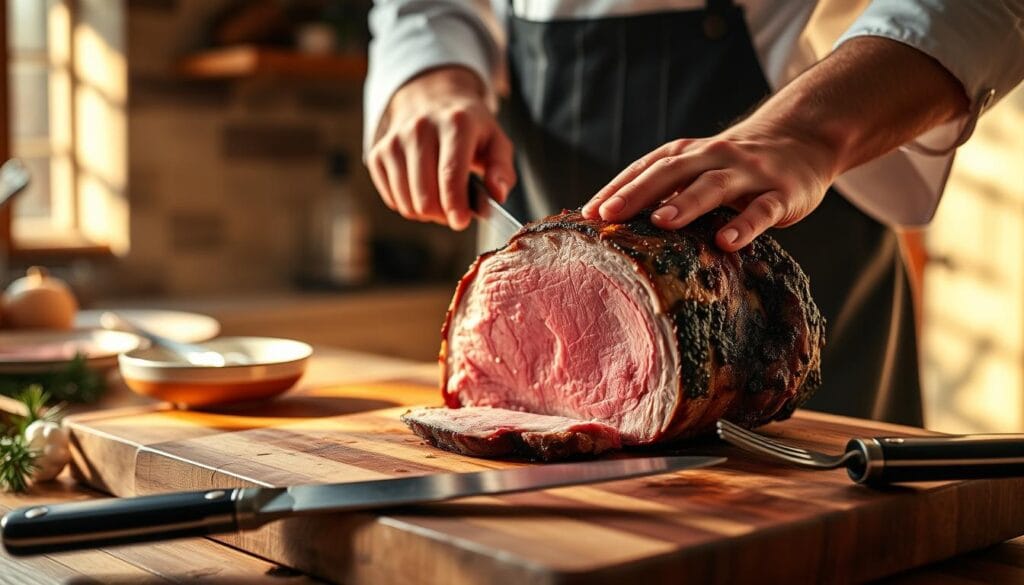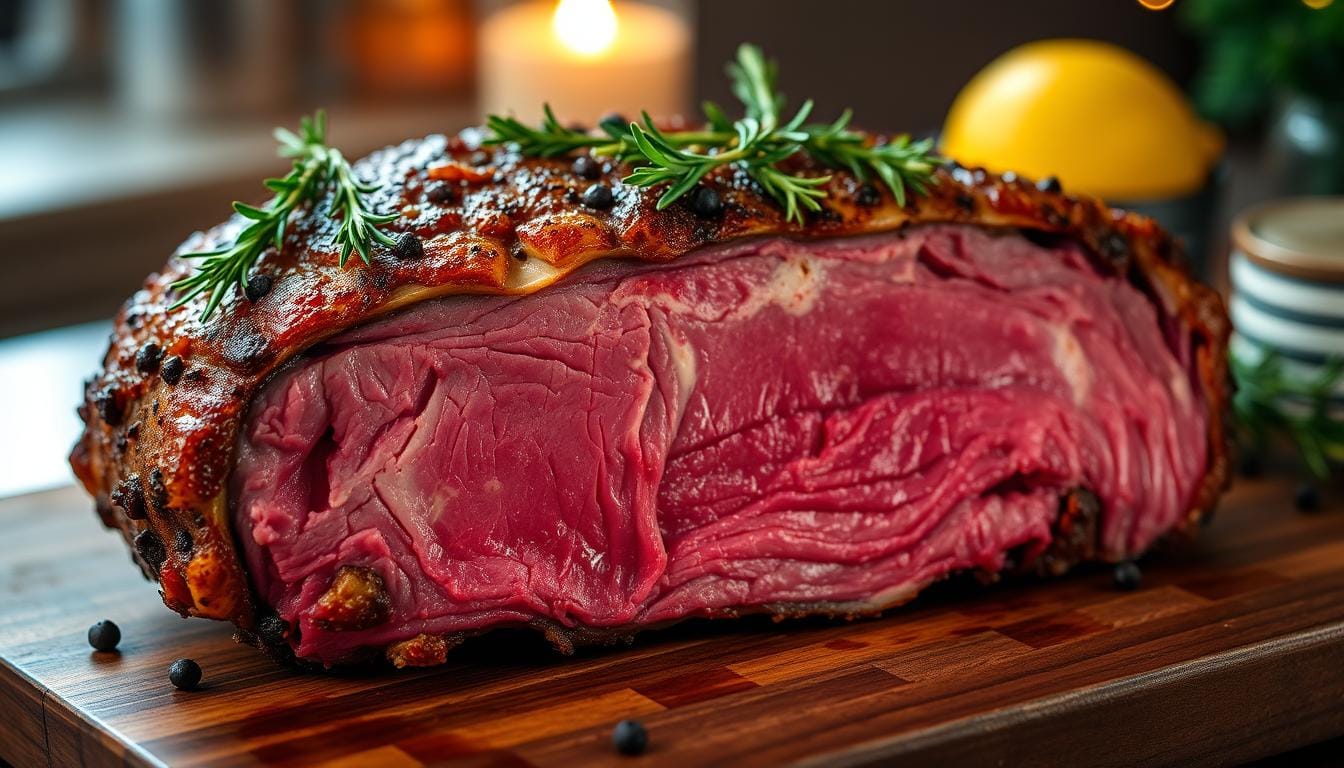You’re planning a holiday dinner that will wow your guests. You’re looking for a dish that’s tasty and easy to make. You don’t want to spend hours in the kitchen.
A perfect prime rib roast is just what you need. It’s perfect for holiday meals. With the right recipe, you can make it tender and full of flavor.
Our Easy Prime Rib Roast recipe is here to help. It’s simple and quick. You’ll make a dish that everyone will love.
Table of Contents
Introduction to Prime Rib Roast and Its Appeal
Prime rib roast is a favorite at many special events. It’s known for its tender texture and rich flavor. It’s a key dish for holidays and special gatherings, offering a unique culinary experience.
So, why is prime rib so loved? It’s because of its unique qualities. Prime rib has a lot of marbling, which adds flavor and makes it tender. This marbling is the fat in the meat, making it juicy and flavorful.
What Makes Prime Rib Special?
Prime rib’s appeal comes from several factors. Its rich flavor is enhanced by the marbling, making each bite a joy. Its tender texture is also a big plus. Plus, the way it looks makes it a showstopper at any event.
If you want to make a memorable meal, prime rib roast is a great choice. You can try different recipes, like our easy ribeye roast recipe with garlic, to find your favorite.
The Perfect Cut for Your Roast
Choosing the right cut of prime rib is key for the best results. The cut affects the flavor, tenderness, and look of your roast.
| Cut | Description | Best For |
|---|---|---|
| Prime Rib | Known for its rich flavor and tender texture, this cut is ideal for special occasions. | Holiday gatherings, special events |
| Ribeye Roast | Offers a good balance between flavor and tenderness, with a slightly leaner profile. | Smaller gatherings, everyday special meals |
| Boneless Prime Rib | Easier to carve and serves a more uniform presentation. | Those who prefer ease of carving |
When picking your prime rib, think about the size of your gathering and what you like. A classic prime rib roast will always impress, no matter the cut.
Essential Ingredients for a Prime Rib Roast
Making the perfect prime rib roast starts with knowing the right ingredients. To get a delicious prime rib roast, focus on the quality and mix of ingredients.
Key Meat Cuts
The prime rib roast is the main attraction. For a simple prime rib roast, choose a high-quality cut. Look for a roast with a good mix of meat and fat for tenderness and flavor. A roast with fat on top stays moist while cooking.
As
“The quality of the meat is crucial for a prime rib roast. A well-marbled roast will result in a more tender and flavorful dish.”
Choosing the right cut is key to a successful prime rib roast.
Spice Blends and Seasonings
A homemade prime rib roast depends on spice blends and seasonings. A mix of salt, black pepper, and garlic powder is a good start. You can add herbs like thyme, rosemary, or paprika for a unique taste.
Additional Ingredients to Enhance Flavor
Other ingredients can also boost the flavor. Onions and garlic add depth. Beef broth or au jus can keep the roast moist and add flavor.
In short, a delicious prime rib roast comes from quality ingredients and how they’re mixed. With a focus on prime rib, the right spices, and extra ingredients like onions and garlic, you’ll make a memorable dish.
Preparing the Prime Rib: Step-by-Step Guide
A perfectly cooked prime rib roast begins with the right preparation. We’ll guide you through it. To get a perfect prime rib roast, preparation is key.
Choosing the Right Size Roast
Choosing the right size roast is crucial. It ensures everyone gets enough. A good rule is 1 pound of prime rib per person.
If you’re hosting a big group or want leftovers, add more. For a quick prime rib recipe, pick a roast that fits your oven well. A too-large roast may not cook evenly. A too-small one might not impress enough.
Preparing the Meat for Cooking
After picking your prime rib roast, prepare it for cooking. Start by seasoning it with salt, pepper, and herbs. For an easy prime rib roast recipe, use garlic powder, thyme, and rosemary.
Let the prime rib sit at room temperature for 30 minutes before cooking. This ensures even cooking. If you can, let it sit longer or even overnight in the fridge to deepen flavors.
By following these steps, you’ll be on your way to a perfect prime rib roast that will wow your guests.
Cooking Methods for Prime Rib Roast
Choosing the right cooking method for a classic prime rib roast is key. It affects the flavor and texture. Each method has its own benefits, like getting a perfect crust or keeping the meat juicy.
Oven Roasting
Oven roasting is a favorite for prime rib. It cooks evenly and browns well. Start by heating your oven to 450°F to sear the roast. Then, lower the heat to cook it to your liking.
Benefits of Oven Roasting: It gives a nice crust and keeps the inside juicy. Plus, it’s easy and doesn’t need much watching.
Slow Cooking for Tenderness
Slow cooking makes prime rib roast tender. Use a slow cooker or crock pot. Cook it on low for hours until it’s tender.
Tips for Slow Cooking: Season the roast well before cooking. Adding veggies like carrots and potatoes to the slow cooker makes a full meal.
Grilling for Flavor
Grilling adds a smoky flavor to prime rib roast. Sear it over high heat for a crust. Then, move it to a cooler part of the grill to finish cooking.
Grilling Tips: Keep your grill clean and oiled to avoid sticking. Use a meat thermometer to check the internal temperature.

| Cooking Method | Benefits | Tips |
|---|---|---|
| Oven Roasting | Even cooking, nice crust | Sear at high heat, then reduce temperature |
| Slow Cooking | Fall-apart tender, easy to prepare | Season liberally, add vegetables |
| Grilling | Smoky flavor, nice crust | Clean grill, use thermometer |
Ideal Cooking Temperature and Timing
To cook a prime rib roast that’s both tender and flavorful, it’s crucial to get the temperature and timing just right. Achieving the perfect prime rib roast involves understanding the nuances of cooking temperature and the importance of timing.
Using a Meat Thermometer
Using a meat thermometer is crucial for achieving the perfect doneness. It takes the guesswork out of cooking, ensuring your prime rib roast is cooked to your desired level of doneness. For an easy prime rib roast recipe, invest in a good quality meat thermometer.
- Insert the thermometer into the thickest part of the roast, avoiding any fat or bone.
- For medium-rare, the internal temperature should be between 130°F and 135°F.
- Refer to a reliable prime rib recipe for specific temperature guidelines.
Understanding Doneness Levels
Doneness levels are a matter of personal preference, ranging from rare to well-done. Understanding these levels is key to cooking your prime rib roast just right.
- Rare: 120°F – 130°F. The meat will be red and juicy.
- Medium Rare: 130°F – 135°F. A popular choice for prime rib, offering a balance between tenderness and flavor.
- Medium: 140°F – 145°F. The meat will be slightly pink in the center.
For more detailed cooking instructions and variations, you can visit other recipes that might inspire your next culinary adventure.
Resting the Prime Rib: Why It Matters
The resting period is crucial when cooking a delicious prime rib roast. After cooking it to perfection, it’s key to let it rest before carving.
Benefits of Resting Your Roast
Resting your prime rib makes it more tender and flavorful. This step is vital for a simple prime rib roast that’s juicy and tasty. It allows the juices to spread evenly, making the meat tender and easy to carve.
For more detailed guidance on cooking the perfect prime rib, check out this prime rib recipe. It covers the entire cooking process.
How Long Should You Rest?
The resting time depends on the roast’s size. For a typical-sized roast, rest it for 15 to 20 minutes. Larger roasts might need more time. The goal is to let the juices spread evenly, making the meat tender and flavorful.
By adding this resting period, you’ll get a prime rib that’s not only delicious but also looks great when served.
Sides That Pair Perfectly with Prime Rib
To make a complete meal, pair your homemade prime rib roast with tasty sides. The right sides can boost the flavors and textures of your prime rib. This makes your meal more enjoyable.
Classic Sides to Consider
Classic sides are loved for a reason. They match the rich taste of prime rib without taking over. Here are some favorites:
- Roasted vegetables, like asparagus or Brussels sprouts, offer a nice texture contrast.
- Mashed potatoes are a comforting side that goes well with prime rib’s savory flavors.
- Horseradish sauce is a traditional choice that adds a spicy kick.
For a detailed recipe on a delicious side, check out our guide on slow cooker country ribs. It shares tips on matching flavors.
Creative Takes on Traditional Pairings
While classic sides are great, you might want to try something new. Here are some creative twists on traditional pairings:
| Classic Side | Creative Twist |
|---|---|
| Mashed Potatoes | Loaded mashed potatoes with garlic, cheese, and bacon |
| Roasted Vegetables | Roasted root vegetables with a honey and balsamic glaze |
| Horseradish Sauce | A spicy horseradish and cheddar creami sauce |
By using these ideas, you can make a juicy prime rib roast meal that’s both satisfying and memorable. Whether you choose classic or creative sides, your prime rib dinner will be a hit.
Tips for Carving Your Prime Rib Roast
Carving your prime rib roast can be easy with a few tips. It’s important for both looks and taste. To get tender slices, carve against the grain. You’ll need to know the meat’s structure and have the right tools.
Tools You’ll Need
You’ll need a few tools to carve your prime rib roast well. A sharp carving knife is key for clean cuts. A carving fork helps hold the roast steady. Also, a cutting board with a groove catches juices and keeps your counter clean.

Best Techniques for Carving
The way you carve your prime rib roast matters a lot. Always carve against the grain for tender slices. First, find the muscle fibers’ direction, then slice the opposite way. For a perfect prime rib roast, aim for 1/4 inch thick slices. This thickness is just right for tenderness and flavor.
| Carving Technique | Description | Benefit |
|---|---|---|
| Slice Against the Grain | Identify the muscle fibers and slice in the opposite direction | Tender slices |
| Use a Sharp Knife | Ensure your carving knife is sharp | Clean cuts, less tearing |
| Slice to Desired Thickness | Aim for 1/4 inch thick slices | Balance between tenderness and flavor |
Follow these tips and use the right tools to carve your prime rib roast like a pro. Your easy prime rib roast recipe will impress everyone. Whether it’s for a big gathering or a special dinner, how you carve your prime rib makes a big difference.
Conclusion: Serving and Enjoying Your Prime Rib Roast
Now that you’ve learned how to cook a tasty prime rib roast, it’s time to serve it. A well-presented roast will impress your guests. It will be the highlight of your holiday meal.
Presentation Tips
To make your prime rib roast look good, slice it thinly against the grain. Place the slices on a platter with fresh herbs like thyme or rosemary. This adds color and a great smell, making it more appealing.
Storing Leftovers
If you have leftovers, store them right to enjoy your prime rib roast again. Slice the remaining roast and put it in an airtight container. Refrigerate it. You can also freeze it for later use in sandwiches or salads.
By following these tips, you’ll enjoy your prime rib roast fully. Whether it’s for a special occasion or a cozy family dinner, it’s sure to be a hit.

